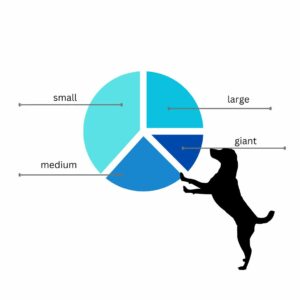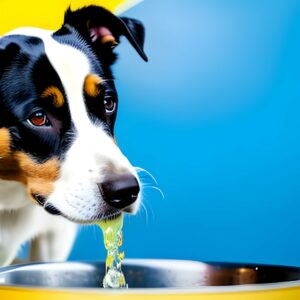I’ve owned and rescued many dogs. This comes with facing many health conditions but bloat is by far the fastest-developing health issue in dogs.
Our team of vets and the American Kennel Club (AKC) categorize bloat as a medical and surgical emergency due to its rapid progression and potential complications.
The prognosis and survival rate for bloat depends on:
1. Timely Veterinary Intervention
The sooner you bring your dog to a clinic, the better the chances for a positive outcome.
2. Severity of the Condition
The extent of organ damage and the response to treatment will influence the prognosis for each affected dog.
3. Underlying Health and Breed Predisposition
Dogs with compromised health may have a poorer prognosis due to potential complications and reduced resilience.
4. Post-Treatment Care and Management
The commitment of the dog owner to follow the prescribed care plan can significantly impact the overall prognosis and the dog’s long-term well-being.
In this piece, we will talk about the symptoms, causes, treatment, and prevention of bloating.
Bloat in Dogs: Table of Contents
What is Bloat in Dogs?
Bloat ( gastric dilatation-volvulus (GDV), is a serious life-threatening condition for dogs.
It occurs when the dog’s belly fills with gas, fluid, or food and then twists on its axis, resulting in a blockage.
This twisting can cut off the blood supply to the stomach and prevent blood in the abdomen from returning to the heart, leading to tissue damage and other complications.
Bloat can affect any breed of dog, but it is more commonly observed in large-breed or deep-chested dogs.
Giant-breed dogs and Large breeds, such as Great Danes, St. Bernards, Akita, Boxers, Doberman Pinschers, Gordon Setters, Standard Poodles, Irish Setters, German Shepherds, and Weimaraners, are particularly susceptible to bloat. Dogs that have a deep chest and narrow waist are also at a higher risk of developing bloat.
The risk of bloat increases with age.
Dogs aged 7.0-9.9 years old have a higher risk of bloat compared to dogs aged 2.0-3.9 years old.
The risk is more than twice as high in dogs aged 7.0-9.9 years old and more than three times as high in dogs aged 10 or older.
The Two Types of Bloat: Gastric Dilatation and Gastric Torsion
There are two main types of bloat in dogs:
- gastric dilatation
- gastric torsion
Gastric dilation is when the stomach fills with air, fluid, or food and becomes bloated. This can happen when the dog is eating too fast, eating too much, or exercising too soon after eating.
Gastric torsion is when the bloated stomach twists on itself, causing even more serious health problems.
This twisting can prevent the stomach from emptying, leading to a buildup of gas and fluid. The pressure from this buildup can cause the stomach to rupture, which can be fatal for your dog.
What triggers bloat in dogs?
The exact cause of bloat is not well understood, but several factors may contribute to its development, including:
- genetics
- breed anatomy
- eating habits
- exercise patterns
Anatomical Factors
Large and deep-chested breeds, such as Great Danes, Saint Bernards, and Weimaraners are particularly susceptible to the condition. This is because their deep chests leave less room for their stomachs to expand, making it easier for them to become twisted or blocked.
Dogs that are older or have a history of digestive problems, such as inflammatory bowel disease, are more likely to develop bloat.
Dietary Factors
The type of food your dog eats can also contribute to their risk of developing bloat.
Feeding your dog one large meal a day, or feeding them a diet that’s high in fat, can increase their risk of developing bloat.
This is because a large meal can cause the stomach to expand quickly, putting more pressure on other organs.
If your dog eats too quickly, they may swallow air, which can lead to bloat.
To reduce your dog’s risk of developing bloat, consider feeding them smaller meals throughout the day and using a slow feeder bowl to help slow down their eating and feed the appropriate food.
Behavioral Factors
Dogs that are anxious or under stress may be more likely to develop bloat. This is because stress can cause the body to produce more gas, which can contribute to the condition.
Dogs that are overly active after eating, or that drink a lot of water immediately following a meal, may be at higher risk.
To help reduce your dog’s risk of developing bloat, try to keep them calm and relaxed after meals, and limit their water intake for at least an hour after eating.
Genetic Predisposition
While the exact causes of bloat are not fully understood, some research suggests that bloat may have a genetic component, meaning that certain dogs may be more predisposed to developing the condition.
If your dog has a family history of bloat, it may be at greater risk of developing the condition. Additionally, if you are considering getting a dog that is known to be at high risk for bloat, it’s important to talk to your veterinarian about ways to reduce their risk and monitor them for signs of the condition.
Symptoms of Bloat
Recognizing the symptoms of bloat is important for early detection and treatment. Below are some of the most common symptoms of bloat in dogs.
Early Warning Signs
During the early stages of bloat, your dog may exhibit some of the following symptoms:
- Retching or attempting to vomit
- Restlessness and pacing
- Excessive salivation
- Swollen stomach
- Weakness and lethargy
- Drool
Progression of Symptoms
If left untreated, bloat can progress quickly and have severe consequences:
- Difficulty breathing
- Fainting or collapse
- Unproductive retching or vomiting
- Pale gums
- Rapid heart rate
Diagnosing Bloat in Dogs
Diagnosing bloat in dogs can be challenging, as the condition can have a variety of symptoms.
Your veterinarian will typically start with a physical examination, which may include blood tests and diagnostic imaging. Below are some of the methods used to diagnose bloat in dogs.
Physical Examination
During a physical examination, your veterinarian will check your dog for signs of bloat, such as a swollen stomach or discomfort. They may also check your dog’s heart rate and breathing.
Diagnostic Tests
If your veterinarian suspects that your dog is experiencing bloat, they may order diagnostic tests, such as X-rays or ultrasounds, to confirm the diagnosis.
Differential Diagnosis
Other medical conditions, such as bowel obstruction or pancreatitis, may present with symptoms similar to bloat. Your veterinarian will work to rule out other potential causes before diagnosing bloat.
Treatment for Bloat in Dogs
If your dog has been diagnosed with bloat, prompt treatment is essential. Treatment options will depend on the severity of your dog’s condition but may include:
Stabilization
To stabilize your dog, your veterinarian may administer intravenous fluids and medication to manage symptoms such as pain and nausea.
Decompression
To relieve the pressure caused by the bloated stomach, your veterinarian may insert a tube into your dog’s stomach to allow gas and fluid to escape.
Surgery
In more severe cases of bloat, surgery may be necessary to repair any damage caused by the condition and prevent it from recurring.
Gastropexy is a surgical procedure that is performed in dogs, primarily large breed dogs, to help prevent gastric dilatation and volvulus (GDV)
Gastropexy can be performed for two main purposes:
Prophylactic Gastropexy: This is done as a preventive measure in healthy dogs that are predisposed to GDV due to their breed or anatomy. The procedure aims to permanently attach the stomach to the body wall, preventing it from rotating and reducing the risk of bloat in the future.
Emergency Gastropexy: During emergency surgery for dogs experiencing GDV, gastropexy is performed after untwisting the stomach to prevent the recurrence of the condition. This helps to secure the stomach in its correct position and prevent future episodes of GDV.
The procedure itself involves attaching the pyloric antrum (part of the stomach) to the right side of the abdominal wall, effectively anchoring the stomach in place.
Gastropexy can often be completed in most local veterinary clinics or hospitals by a veterinary medicine licensed veterinarian. It is generally considered a low-risk procedure with a low incidence of complications.
The benefits of gastropexy include a significant reduction in the risk of bloat recurrence. Without gastropexy, approximately 76% of dogs that have experienced GDV may have another episode, many within three months.
By securing the stomach, gastropexy helps to prevent the life-threatening complications associated with GDV and can potentially save a dog’s life.
In severe cases, speen and pancreas can also get twisted and cause clothing. Vets will likely have to remove the speel as well.
If you are considering gastropexy for your dog, it is important to consult with a veterinarian who can evaluate your dog’s specific circumstances, assess their risk for GDV, and provide appropriate recommendations. The decision to perform gastropexy should be made based on individual factors such as breed predisposition, medical history, and the veterinarian’s professional judgment.
Preventing Bloat in Dogs
Preventing bloat in dogs is key to ensuring their health and well-being. Some strategies for preventing bloat include:
Feeding Your Dog Smaller Meals
Instead of feeding your dog one large meal a day, feed them smaller meals throughout the day. This can help to prevent the stomach from becoming overly full and bloated.
Our Nutritional guide can help you understand feeding in older dogs.
Feeding Your Dog a High-Quality Diet
Feeding your dog a diet that’s high in fiber and low in fat can help to reduce their risk of developing bloat.
Slowing Down Your Dog’s Eating
If your dog tends to eat quickly, try using a specialized bowl or feeding them smaller portions to slow them down. This can help to prevent them from swallowing air, which can lead to bloat.
Reducing Stress and Anxiety
If your dog is prone to anxiety, try to reduce stressors in their environment and provide them with plenty of exercise and mental stimulation.
Gastropexy
A surgical procedure that can help reduce the risk of bloat.
See the full explanation above.
Bloat in dogs FAQ and takeaways
Is bloat in dogs life-threatening?
Yes, bloat in dogs is considered a serious and potentially life-threatening condition. Bloat can lead to tissue damage, organ dysfunction, shock, and even death if left untreated.
What should I do if I suspect my dog has bloat?
If you suspect your dog is experiencing bloat, it is crucial to seek immediate veterinary care. Bloat is an emergency that requires prompt medical intervention for the best chances of a positive outcome.
Bloat is a serious and potentially life-threatening condition that can affect dogs of all breeds and ages. By understanding the causes, symptoms, and treatment options for bloat, you can help to keep your furry friend healthy and happy.
-
The Majestic Bernese Mountain Dog: Life With a Berner
Imagine a friend who welcomes you with a tail-wagging symphony, whose eyes hold the warmth of a crackling fire, and whose strength could pull a cart but would rather snuggle on the couch. That’s the Berner: a family companion, a farmhand extraordinaire, and an adventurer always ready for a hike. … Read More
-
Corgi Beagle Mix: Origin, Lifespan, Health & Care Tips
The Corgi Beagle Mix, also known as the Beagi, is a unique blend that brings together the best qualities of both breeds, resulting in a charming companion. In this article, we will explore the fascinating world of the beagi, shedding light on its origin, physical characteristics, temperament, health, and care … Read More
-
Koi Fish In Winter: A Guide to Koi Pond Winter Care
Although Koi fish are relatively easy to care for, seasonal changes require extra care. And winter is no exception! Most Koi fish can withstand lower temperatures but are vulnerable to potential water freezing. In this article, we’ll talk about the best ways to take care of your Koi fish in … Read More
My Senior Paws is a participant in the Amazon Services LLC Associates Program, an affiliate advertising program designed to provide a means for sites to earn advertising fees by advertising and linking to Amazon.com. We also participate in other affiliate programs which compensate us for referring traffic.







